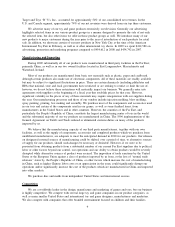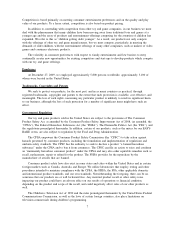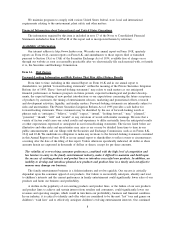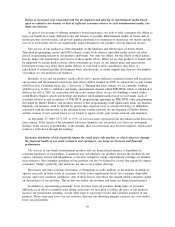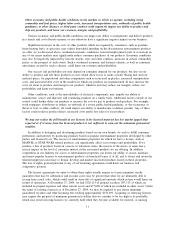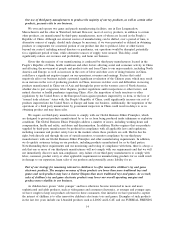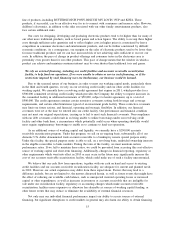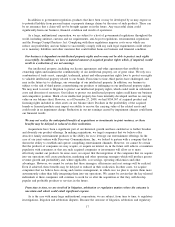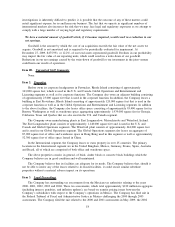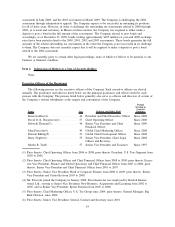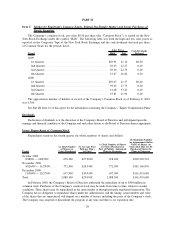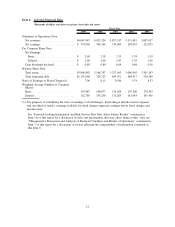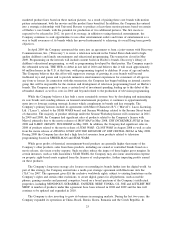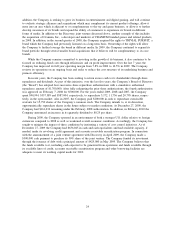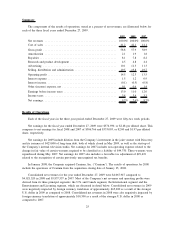Hasbro 2009 Annual Report Download - page 25
Download and view the complete annual report
Please find page 25 of the 2009 Hasbro annual report below. You can navigate through the pages in the report by either clicking on the pages listed below, or by using the keyword search tool below to find specific information within the annual report.line of products, including BUTTERSCOTCH PONY, BISCUIT MY LOVIN’ PUP and KOTA. These
products, if successful, can be an effective way for us to connect with consumers and increase sales. However,
children’s electronics, in addition to the risks associated with our other family entertainment products, also
face certain additional risks.
Our costs for designing, developing and producing electronic products tend to be higher than for many of
our other more traditional products, such as board games and action figures. The ability to recoup these higher
costs through sufficient sales quantities and to reflect higher costs in higher prices is constrained by heavy
competition in consumer electronics and entertainment products, and can be further constrained by difficult
economic conditions. As a consequence, our margins on the sales of electronic products tend to be lower than
for more traditional products and we can face increased risk of not achieving sales sufficient to recover our
costs. In addition, the pace of change in product offerings and consumer tastes in the electronics area is
potentially even greater than for our other products. This pace of change means that the window in which a
product can achieve and maintain consumer interest may be even shorter than traditional toys and games.
We rely on external financing, including our credit facilities and accounts receivable securitization
facility, to help fund our operations. If we were unable to obtain or service such financing, or if the
restrictions imposed by such financing were too burdensome, our business would be harmed.
Due to the seasonal nature of our business, in order to meet our working capital needs, particularly those
in the third and fourth quarters, we rely on our revolving credit facility and our other credit facilities for
working capital. We currently have a revolving credit agreement that expires in 2011, which provides for a
$300,000 committed revolving credit facility which provides the Company the ability to request increases in
the committed facility in additional increments of $50,000, subject to lender agreement, up to a total of
$500,000. The credit agreement contains certain restrictive covenants setting forth leverage and coverage
requirements, and certain other limitations typical of an investment grade facility. These restrictive covenants
may limit our future actions, and financial, operating and strategic flexibility. In addition, our financial
covenants were set at the time we entered into our credit facility. Our performance and financial condition
may not meet our original expectations, causing us to fail to meet such financial covenants. Non-compliance
with our debt covenants could result in us being unable to utilize borrowings under our revolving credit
facility and other bank lines, a circumstance which potentially could occur when operating shortfalls would
most require supplementary borrowings to enable us to continue to fund our operations.
As an additional source of working capital and liquidity, we currently have a $250,000 accounts
receivable securitization program. Under this program, we sell on an ongoing basis, substantially all of our
domestic U.S. dollar denominated trade accounts receivable to a bankruptcy remote special purpose entity.
Under this facility, the special purpose entity is able to sell, on a revolving basis, undivided ownership interests
in the eligible receivables to bank conduits. During the term of the facility, we must maintain certain
performance ratios. If we fail to maintain these ratios, we could be prevented from accessing this cost-effective
source of working capital and short-term financing. Additionally, changes in financial reporting, regulatory or
other requirements which went into effect in 2010 or may occur in the future may significantly increase the
cost of our accounts receivable securitization facility, which could make use of such a facility uneconomical.
We believe that our cash flow from operations, together with our cash on hand and access to existing
credit facilities and our accounts receivable securitization facility, are adequate for current and planned needs
in 2010. However, our actual experience may differ from these expectations. Factors that may lead to a
difference include, but are not limited to, the matters discussed herein, as well as future events that might have
the effect of reducing our available cash balance, such as unexpected material operating losses or increased
capital or other expenditures, as well as increases in inventory or accounts receivable that are ineligible for
sale under our securitization facility, regulatory or accounting changes which make accounts receivable
securitization facilities more expensive or otherwise less desirable as sources of working capital funding, or
other future events that may reduce or eliminate the availability of external financial resources.
Not only may our individual financial performance impact our ability to access sources of external
financing, but significant disruptions to credit markets in general may also harm our ability to obtain financing.
15



